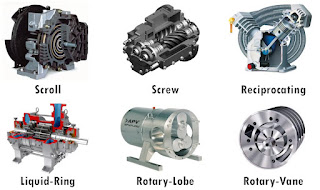- Positive displacement Compressor
- Dynamic Compressor
Positive Displacement Compressor
In volumetric types, a certain amount of air is trapped in the compression chamber, and the occupied volume is mechanically reduced, resulting in increased pressure before discharge. Rotary screws, vain, and reciprocating compressors are three standard positive displacement air compressors found in small and medium-sized businesses.
Dynamic Compressor
Dynamic air compressors include centrifugal and axial compressors and are used in huge industries. These units are outside the scope of this document.
-
Rotary Screw compressors
Screw compressors have gained popularity and market share (compared to reciprocating compressors) since the 1980s. These units typically range in size from 5 to 900 horsepower. The most common type of rotary compressor is a twin-screw compressor. Two linked rotors come together, capture air, and reduce the volume of air along the rotors. Depending on the requirements for air cleanliness, screw compressors are available in lubricated or dry (oil-free) versions.
The most significant advantage of screw compressors over smaller air-cooled reciprocating units is that they can operate continuously at full load. In contrast, reciprocating compressors must operate at a 60% duty cycle or less. The rotating screws are very quiet and produce cool air for easy drying. Note that screw compressors may not be the most efficient choice compared to start/stop reciprocating compressors. For example, see Case 3: On/Off versus load/no load control on page 101.
Lubricated rotating screw.
The oil-injected rotary screw compressor is the dominant industrial compressor for press plants. In rotary screw compressors with oil injection, lubricants can be hydrocarbon compounds or synthetic products. Typically, a mixture of compressed air and injected lubricant flows from an air nozzle into a reservoir where the lubricant is forced out of the compressed air. The change in direction and speed is used to separate the fluids further. Aerosols remaining in the compressed air are then separated by a separator inside the sump, resulting in a few parts per million (ppm) lubricant transferred to the compressed air.
In two-stage compressors, interstage cooling and internal low-pressure losses in each stage increase compression efficiency. As a result, less energy is required to compress the air to the final pressure.
Dry rotary screw.
In the dry type, the locking rotors do not contact each other, and their relative distance is maintained with minimal tolerances by externally lubricated gears. Most designs use two compression stages with an intercooler and an aftercooler. Oil-free screw compressors range from 25 to 1,200 horsepower or 90 to 5,200 cfm.
-
Reciprocating compressors
Reciprocating compressors have a piston driven by a crankshaft and an electric motor. General-purpose reciprocating compressors are commercially available in sizes from less than 1 horsepower to 30 horsepower. Reciprocating compressors often supply air to building automation and control systems. Large reciprocating compressors are still in the industry but are no longer commercially available except for use in specialized processes such as high-pressure applications.
-
Rotary Vane compressors
A rotary vane compressor uses an elliptical rotor inside a cylinder. The rotor has slots along its entire length; each slot has a blade. As the compressor rotates, the vanes are pushed outward by centrifugal force, and the vanes move in and out of the groove because the rotor is off-center from the housing. The vanes sweep the cylinder, draw air from one side, and release it from the other side. As a rule, pallet compressors are used for small installations where the floor area is small. However, they are not as efficient as screw compressors.
-
Compressor motors
Electric motors are widely used to drive compressors. As the prime mover, the engine must provide sufficient power to start the compressor, accelerate to full speed, and operate the unit under various design conditions. Most air compressors use standard three-phase asynchronous motors.

